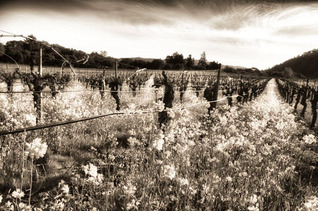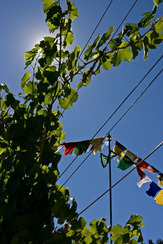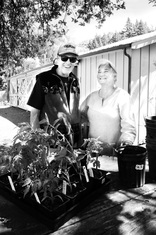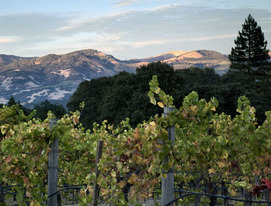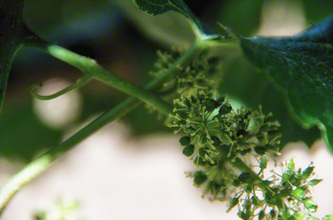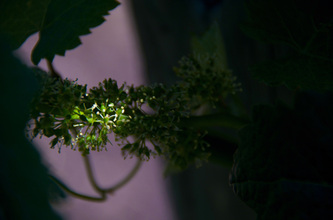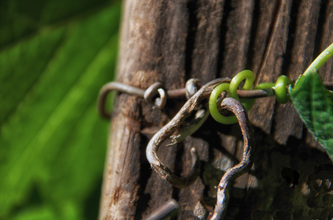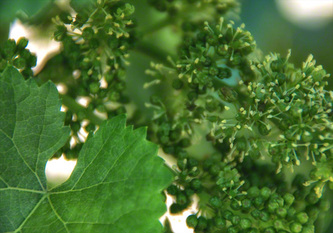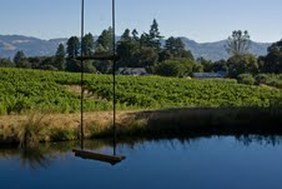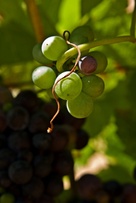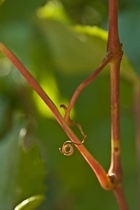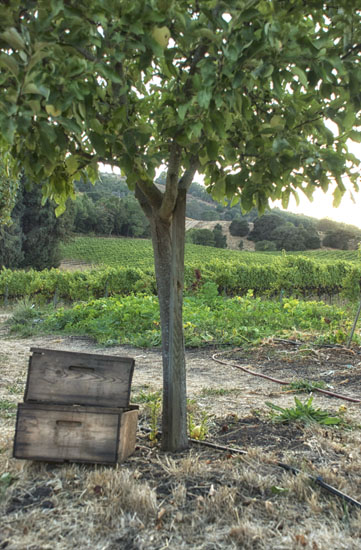van der Kamp - Sonoma Mountain
Photographers: Mikala Kennan, Adriana Arriaga, and Cathleen Francisco
Story: Cathleen Francisco
Story: Cathleen Francisco
Sonoma Mountain, once part of the Pacific Ocean floor, rises 2463 feet above sea level. Fog from the coast defines the climate on the western flank of the mountain, while the eastern slope, facing out to the Mayacamas range, drinks in sunlight for most of the day. With stunning reliability, the fog finds its way up rivers and through gaps in the landscape, reaching out with fingers of moist air that move around the mountain, cooling the sun soaked eastern slope. Natural springs fed by the mountain add to the macro climates, becoming part of the vital watersheds that sustain forests of oak and Pacific Madrone, the delicate riparian zones of Coast redwood, and feed the rivers and wetlands in the valleys and basins below.
The human history of the mountain goes back thousands of years. In the legends of Coast Miwok, the world was born from the floor of the ocean and the highest peak of Sonoma Mountain was the beginning of the world. They named it O’ na-pa’is - House of the Moon and from its valley in the East, they believed the moon rose. Not specific to any one tribe, the area was used mainly for winter trading between the Pomos from the villages along the Russian River, Hupas from the East and the Coast Miwok whose territory extended as far south as San Francisco Bay.
The human history of the mountain goes back thousands of years. In the legends of Coast Miwok, the world was born from the floor of the ocean and the highest peak of Sonoma Mountain was the beginning of the world. They named it O’ na-pa’is - House of the Moon and from its valley in the East, they believed the moon rose. Not specific to any one tribe, the area was used mainly for winter trading between the Pomos from the villages along the Russian River, Hupas from the East and the Coast Miwok whose territory extended as far south as San Francisco Bay.
|
In the early 1800s Spanish missionaries and Russian explorers had already begun their migration into the area altering the cultural landscape and by the mid-1800s settlers from the East had turned much of the land in the valley into one form of agriculture or another. What land remained was on the steeper hillsides of the mountain. Loggers had removed much of the redwood and fir leaving open spaces that the daring and the desperate attempted to farm. Steep hillsides, with delicate volcanic soil prone to erosion, made traditional crops difficult to sustain, leaving farmers discouraged and many of the homesteads abandoned - but some not only survived, they thrived.
|
|
On the eastern flank of Sonoma Mountain, at the headwaters of Sonoma Creek is the van der Kamp vineyard. One of the oldest homesteads on the mountain, it has been farmed continually for over one hundred years with the crops not much different over time and always planted to some variety of grapevine. At an elevation of 1250 to 1500 feet, they sit above the frost line. Two fog banks move up on opposite sides of the vineyard - one from the Petaluma gap that winds up the Russian River and the other that comes in from the bay. They meet and, as Martin van der Kamp says, “do battle," pushing each other aside, creating an opening where sunlight pours in. Because it is a north facing bench, growing conditions are perfect for Pinot Noir - cool, with an abundance of sunshine - and yet, just a few hundred yards past the vineyard, the climate is warmer and far more suitable for Cabernet or Zinfandel. It is these unique climatic conditions that are so prevalent on Sonoma Mountain making it one of the most diverse growing regions in the county.
|
Martin van der Kamp started making wine in the late 60s, buying much of his fruit from the vineyard he would one day call home for his wife and six children. When they bought the land in ‘89 it was mostly Pinot Noir and Cabernet Sauvignon, with a few acres planted to Chardonnay and Golden Chasselas (an old time grape planted during Prohibition to make altar wines). Martin and Dixie were then in the champagne business. They cherished the original Pinot Noir vines, which are still carefully maintained and are among the oldest still producing in Sonoma County. The rest of the 25 acre vineyard was replanted to a variety of Pinot Noir clones as well as the hard-to-find Pinot Meunier, traditionally used in classic champagne blends. As time went on, Martin and Dixie became aware that being caretakers of this unique place spoke more to their passions and beliefs, so with their son, Ulysses, who was taking charge of the vineyard and farming operations, they left the business of making and selling wine and turned their energies to the land. The grapes have responded, prized by the wineries who offer their wines as vineyard designates.
|
The homestead is, in the truest sense, a working family farm. While the vineyard is awarded celebrity status, the rest of the farm is dedicated to gardens, hens and roosters, orchards and cultural quests. Its success due to the unity of natural resources that sustain them, and of equal importance, the deep connection the van der Kamps feel for the land. Along with Martin and Dixie, Ulysses lives with his family on the property as do two other families who provide the extra labor the farm requires year round; between them all, they grow and raise all that they need. They farm in a manner that is sustainable and when they talk about farming, it is not just the physical act they speak of, but a spiritual one as well.
|
Ulysses has farming at his core, being a descendent on his father's side of the Napa Petersen’s who started growing grapes in 1879 and shortly after, began wine making. Biodiversity is at the heart of his farming practices and what guides him. Rather than a monoculture, which rails against natures balance, biodiversity joins all forms of agriculture in a sustainable way that best reflects nature. Ulysses knows every aspect of the farm, every turn and dip in the landscape, and like any good farmer, he learns from each season, responding to changes rather than reacting to them. He prunes each of the vines himself and in the growing season, walks the vineyard daily assessing the development of each cluster. Martin once commented “the best fertilizer for a vineyard is the shadow of the farmer” and farmer Ulysses casts a long, loving shadow.
The care given the vineyard resonates in the relationship they have with the wineries and winemakers that buy their fruit - it is not just about the wine produced, but a personal connection and shared values. It is more than quality farming that produces such outstanding fruit - there is something more here - Dixie says it is a healing place. In the book, The One-Straw Revolution, Masanobu Fukuoka writes, “The ultimate goal of farming is not the growing of crops, but the cultivation and perfection of human beings.”
The care given the vineyard resonates in the relationship they have with the wineries and winemakers that buy their fruit - it is not just about the wine produced, but a personal connection and shared values. It is more than quality farming that produces such outstanding fruit - there is something more here - Dixie says it is a healing place. In the book, The One-Straw Revolution, Masanobu Fukuoka writes, “The ultimate goal of farming is not the growing of crops, but the cultivation and perfection of human beings.”
|
It is an old mountain, vital in the shaping of climates and cultures, a landscape with pockets full of history - some of it told in legends and in books, other aspects continue on, preserved in daily practice and ritual. The van der Kamps have an acute awareness of the importance of the stewardship of such a place - and it is evident in the spirit the land reflects back to them.
|
Flowering: Grapevines are self pollinating so no energy is wasted on large, heavily scented flowers or pitchers of nectar to attract pollinators. Still, despite their small size and inconspicuous nature, there is a sweetness in the air, a distinct aroma announcing the season and promises of whats to come.
"This virtual island oasis perched at the top of Sonoma Mountain Road is much more than a vineyard and garden for the people who tend the land and for the winemakers who make the wine from this exceptional, spiritual site. It is also a place of healing, where Native Americans gather to conduct their ceremonies and where families associated with the van der Kamps come to relax for a moment and let their kids catch their first fish in the spring-fed pond. While there, one can absorb the collective wisdom that emanates from these farmers’ lives that have been filled with discovery outside of the porous walls of this unique vineyard site and brought back to intersect with The Land.
Ulysses van der Kamp farms this land like no other viticulturist. He prunes, pulls leaves and manages each vine with a devotion seldom seen in any vocation of any kind. His hands touch each vine many times over the course of the growing season. His partnership with the land inspires winemakers to give their very best effort to the grapes grown on Sonoma Mountain. He is an indelible part of what the French call terroir as you cannot separate the man from the mountain. He and patriarch and matriarch Martin and Dixie van der Kamp are what make this site so unique." Greg LaFollete
Ulysses van der Kamp farms this land like no other viticulturist. He prunes, pulls leaves and manages each vine with a devotion seldom seen in any vocation of any kind. His hands touch each vine many times over the course of the growing season. His partnership with the land inspires winemakers to give their very best effort to the grapes grown on Sonoma Mountain. He is an indelible part of what the French call terroir as you cannot separate the man from the mountain. He and patriarch and matriarch Martin and Dixie van der Kamp are what make this site so unique." Greg LaFollete
Harvesting at night is better for the fruit, the workers, the winemakers and the environment. Fruit chemistry is more balanced at night and wild yeasts are dormant when temperatures are cool. Harvest is labor intensive and for the workers, picking in the twilight hours is far more pleasant than picking in the heat of day. An added bonus of picking at night - rattlesnakes and wasps are not active, making them less of a hazard. Winemakers like the fruit coming in cool and docile so they have better control over the process. The environment benefits as well as it requires less water and energy to manage the temperature of the fruit in the early stages of fermentation.
|
Vineyard owners: Dixie and Martin van der Kamp and Ulysses van der Kamp.
Vineyard manager/farmer: Ulysses van der Kamp The van der Kamp family farm is located on the site of one of the original homesteads on Sonoma Mountain. The ranch has been farmed continuously for 100 years.
|
Acres: The ranch is 60 acres of which 25 is planted to vines.
Soil Types: Speckles loam, Volcanic Tuff and decomposed streambed. Elevation: 1250 - 1500 feet
Exposure: Northern |
Varieties: Primarily Pinot Noir, some Pinot Meunier
Rootstocks: 3309, 5C, S04, St. George, 1103P
Clones: 828, 777, Swan, Heritage Clone, UCD 23, Martini, and a suitcase clone or two.
|
Wineries who source the fruit: Siduri, La Follette, Buena Vista, DeLoach, Lookout Ridge, 10 Acre, Spell Wines, Abiouness, August Briggs, HDV, Romililly, and Cerridwen.
|
